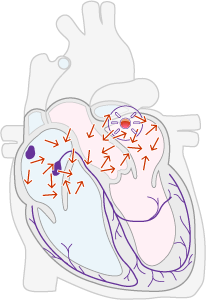Cardiology Teaching Package
A Beginners Guide to Normal Heart Function, Sinus Rhythm & Common Cardiac Arrhythmias
What does AF look like?
The fibrillation, or quivering, that takes place is due to individual muscle fibres contracting independently due to the chaotic conduction within the atria. (see below)
Image: Disorganised electrical activity within the Atria

Note ectopic focus top right corner of atria.
What does AF look like?
In comparison with Sinus rhythm, AF has no P wave as the SA node is not functioning. However, the atria generate up to 600 stimuli/min and each stimuli is picked up by the ECG machine.
So, instead of a P wave, what you see is a number of small waves of differing sizes known as fibrillatory "F" waves.
Because not all the stimuli are strong enough to depolarise the AV node, the rhythm is irregular and due to the number of stimuli actually being generated within the atria, the rhythm tends to be fast, typical 110-140 beats per minute, often higher. (AF is generally, but not always, fast.)
Image: Atrial Fibrillation (AF)

AF is an abnormality that exists above the ventricles and, as a consequence of this, when a stimulus does get conducted through the AV node into the ventricles, the ventricles depolarise as they would do normally and therefore AF will have a normal QRS complex (width less than 3 small squares).
